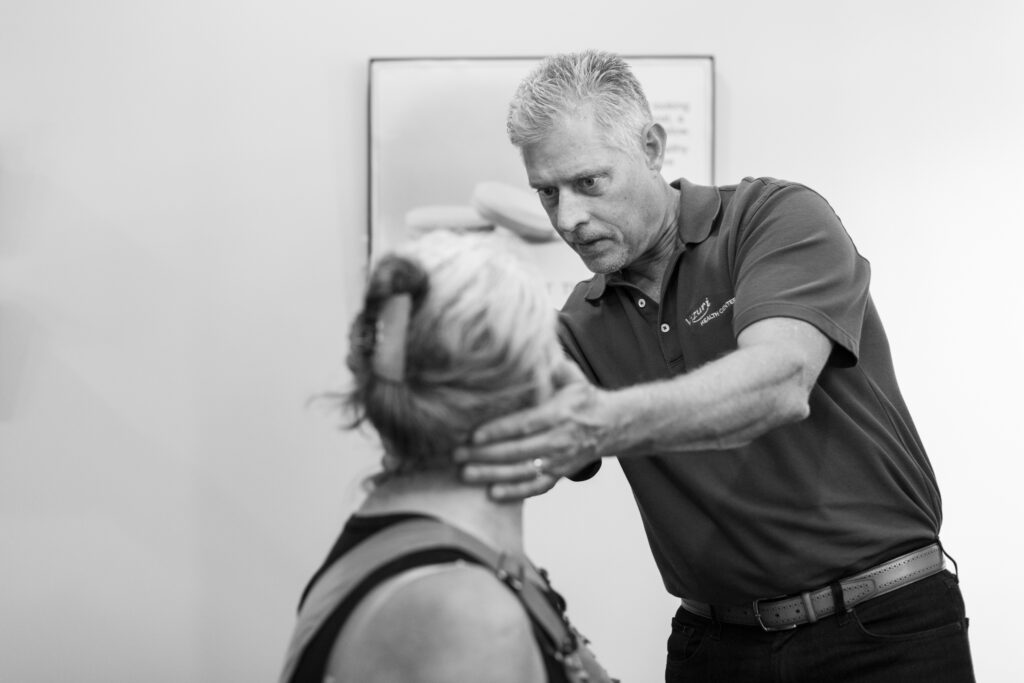Disc Injuries
Explore other conditions we successfully treat
Disc Injuries
Your spine is designed to last a lifetime. The bones, joints, disc, muscles and connective tissue regenerate and adapt to stresses. Only when there is an injury or stress beyond the ability of the body to restore itself to normal does a disc become injured. There are two types of injuries: acute or sudden traumas such as a car accident or fall. The second type of injury is small repetitive injuries that, over time, accumulate so that a disc fails. When a less-than-ideal lifestyle is added to this, healing takes much longer.
Types of Disc Injuries:
Bulged Disc
This type of disc injury is very common – one in seven people walk around with small, bulged discs in their spine with NO symptoms. This means that at some point the disc was injured and began to swell and tear. If the bulge is large enough or in the wrong place, it can put pressure on the spinal cord or the nerve root – this type of disc injury responds very well to conservative care. If a bulge is present in the spine think of it as a warning sign to align and stabilize the spine before it progresses to a more serious disc condition.
Herniated Disc
When the outer fibers of the disc (annulus fibrosis) tear all the way through and the gelatinous nucleus pulposus is pushed out into the tear -the disc is considered “herniated”. The tear itself can cause what is known as discogenic pain – pain arising from the disc. If the herniation is directly onto a nerve root, this puts both physical pressure on the nerve root and the inflammatory chemicals from the disc injury invade the nerve root and cause it to swell as well. With a herniation, there are two causes of pain, direct pressure on nerves and swelling of the nerve.
This is important to understand to successfully treat the herniated disc – it is essential to reduce BOTH the physical pressure on the nerve and to reduce the swelling or inflammation. Must treat both for success
Protruded Disc
When the outer fibers of the disc are torn, and the central disc pushes through and beyond the tear the disc is said to protrude. This is a more serious condition and typically takes longer to heal. The same injury to the nerves applies as in the herniated disc.
Extruded Disc
When the inner nucleus is pushed through the outer fibers and separated from the disc entirely the disc is considered a disc fragment or extruded. This can also be called a sequestered disc. This is the most difficult to manage and may require surgery to remove the fragment.
Spinal Stenosis
Narrowing of any opening is called stenosis, this happens to chronically inflamed arteries, too. In the case of spinal stenosis there is a combination of two factors: thinning of discs and arthritis of the spinal joints, essentially causing bone-on-nerve pressure. The space between the spinal bones or vertebra is called the IVF (intervertebral foramen). There are four sides, if you will, to this opening. On the front side is the disc, top and bottom of the opening are the spinal joints and at the back of the opening is a ligament (ligamentum flavum). When a spinal disc loses water and begins to thin, the IVF narrows top to bottom. At the same time the spinal joints undergo degeneration and begin to develop boney spurs (typically spinal arthritis) further narrowing the opening. As a result of the mechanical stress caused by the disc thinning and the joint arthritis, the ligament thickens. This creates a trifecta resulting in narrowing of the IVF also known as spinal stenosis. Conservative treatment for this is different than a herniated disc. While this condition cannot be “cured”, it can be stabilized and managed.



We have experience with many conditions, both common and rare. If you are looking for answers for a healthier life, explore our services or reach out to us directly. If yours is a condition we cannot help, we will refer you to another provider in our trusted network who can help you.
Ready to Make a Positive Change?
We listen carefully and prescribe a customized treatment plan for each patient’s specific needs utilizing chiropractic, spinal decompression, functional medicine, physical rehabilitation, and lifestyle education to help you regain and maintain your health. We understand your path may be challenging, so we stand by you every step of the way to reach your optimal health.




We provide a dynamic approach to achieve your health goals.
Contact us today to see if you qualify to start your patient journey.
Laying the foundation to accelerate your healing process
Achieving health is like building a house – certain things have to happen in a particular order in order for everything to stand strong and work correctly. When building a house, if you tried to put up your walls before you had a solid foundation, your walls would be weak and eventually collapse. If you tried to put on your roof before the walls were ready, you would run into the same problem. The same is true for your body. Your body has to go through a particular plan of care in order to repair itself correctly and fully. There are three general phases of chiropractic care.


"The doctor of the future will give no medicine, but will instruct his patient in the care of the human frame, in diet and in the cause and prevention of disease."
- Thomas Edison
